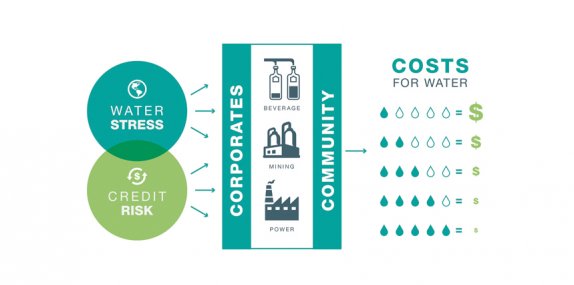
Written by Liesel van Ast, Programme Manager, Natural Capital Declaration.
Several companies are being downgraded by ratings agencies or considering relocating operations due to exposure to local gaps in water supply; while others are building infrastructure or paying higher tariffs to those trying to recover the costs of investing in water security.
Increasing water stress and competition for dwindling resources is emerging in locations worldwide, and the financial implications are likely to increase as rainfall patterns change and droughts become more frequent and severe.
The 2030 Water Resources Group estimated that a greater unpredictability in precipitation as a result of climate change combined with a growing population could lead to a 40% gap between worldwide water supply-and-demand within 15 years. Increasingly, companies are finding it challenging to access sufficient quantities of water for critical business operations, particularly in water-stressed regions. The costs of securing water inputs are already rising for water-intensive companies in those places vulnerable to water shortages. Since 2011, companies have spent more than $84bn worldwide on conserving, managing and obtaining water, according to the Financial Times.
As a result, demand for more systematic ways to quantify and integrate water risk factors into traditional investment analytics has been growing. In response to this need, the Natural Capital Declaration (NCD) – a unique global finance-led and CEO endorsed initiative co-convened by UNEP FI and the Global Canopy Programme, the Deutsche Gesellschaft fur Internationale Zusammenarbeit (GIZ) and the German Association for Environment and Sustainability (VfU) launched an open-source ‘Corporate Bonds Water Credit Risk Tool’ this week. The tool, developed in partnership with seven financial institutions including the NCD Signatories Banorte, Calvert, Robeco and Pax World, introduces geography into credit analysis of 24 major bond issuers in the mining, power and beverages sectors. The global value of corporate bond markets reached $49 trillion in 2013, and many of our pensions are invested in the asset class to try to secure steady returns. It’s obvious by now that hidden risks due to constraints on the ability of companies to repay debt as expected can affect economic stability and livelihoods.
This new tool enables users for the first time to quantify and integrate financial risk exposure to water scarcity into standard financial models which can then be used to assess the credit strengths of corporates across the three water-intensive sectors.
It essentially provides investors with a systematic and practical approach to assess water risk in corporate bonds and benchmark companies against their sector peers, taking account of projected changes in water availability to 2040 by overlaying corporate water use data on World Resources Institute water stress data across locations. This will help users to integrate exposure to water stress into financial analysis, and to engage with the most vulnerable companies to find out how they are managing this risk.
Of the eight mining firms analysed, Barrick Gold and Vedanta are most exposed to water stress. Of the power companies, the South African utility Eskom is most exposed to water stress and could see its financial position deteriorate drastically through operating restrictions or higher capital expenditure due to water shortages. Sempra, RWE and Southern Company also have power plants that are exposed to water stress, and could face shut downs or operate at lower capacity in water-stressed areas. Within the beverages sector, Mexican bottling company Femsa was most exposed to water scarcity.
Users can add more companies to the flexible, Microsoft Excel-based tool, which uses a shadow price for water as a proxy for exposure to potentially increasing costs for water resulting from water stress. The shadow price is weighted by a company’s production at each location to derive an overall company-specific proxy for exposure to water stress, integrating this into traditional financial models.
In addition, a separate tool is available to enable anyone to test the value of water across land-based locations by entering longitude and latitude information.
To access the tool visit http://www.naturalcapitaldeclaration.org/bonds-water-scarcity/
Guest blog post written by written by Liesel van Ast, Programme Manager, Natural Capital Declaration.
Join an international audience of business leaders, government representatives and environmental leaders at the World Forum this November and find out more about latest developments in natural capital tools and accounting. Click here to book your place at the world's leading event on natural capital.
Share this page: